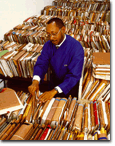

Veterans Benefits Administration
Leaves
Paper Behind on Highway 1
May 3, 1999
Processing claims for Americaís veterans requires a lot of paper. But then, our nation has a lot of veterans. Each claimant has a file folder; each folder gets fuller and fuller as a veteran gets older and older. But does it have to be that way? Can the Department of Veterans Affairs leave paper behind as a new century approaches? The Washington, DC, VA Regional Office is demonstrating an electronic workfolder system. It may be the beginning of a paperless process.
By Pam Gates
 Shortly
after his confirmation as VAís Under Secretary for Benefits, Joe Thompson
approached the National Partnership for Reinvention (NPR) with a proposal
to address some of the technology-based claims processing problems in
the Veterans Benefit Administration.
Shortly
after his confirmation as VAís Under Secretary for Benefits, Joe Thompson
approached the National Partnership for Reinvention (NPR) with a proposal
to address some of the technology-based claims processing problems in
the Veterans Benefit Administration.
Thompson, well aware of the perception that VAís information technology had not kept pace with the demands of claims processing, envisioned a public/private partnership to look at the workload problems and develop solutions that would mesh with existing IT platforms and ongoing development efforts. He hoped this effort would ultimately restore the vitality and credibility of VBAís IT operation, once one of the finest in the federal government.
Thompson approached Greg Woods, Chair of the Government Information Technology Services Board, who was then NPR deputy director. Woods was and is the principal advocate for Vice President Goreís Access America initiative to use information technology to deliver services to the American people and improve government productivity.
A Public/Private Partnership Emerged
A visit to the Washington, D.C., VA Regional Office (VARO), and a meeting with Director Fay Norred and the Compensation and Pension staff, gave Thompson and Woods a better understanding of a typical claims processing operation. They then called on the General Services Administration and Highway 1, a consortium of high technology corporations, and secured their involvement and commitment to a public/private partnership.
Highway 1, named after the first U.S. highway designed to connect disparate communities, is a nonprofit organization that serves as a nonpartisan resource on information technologies for Congress and federal agencies; state and local governments; international officials; nonprofit organizations; and the public. Its mission is to educate government leaders about how to use information technologies to improve efficiency and productivity in their daily work environments, and to improve communication with the American people.
To launch the project, Highway 1 created an "Industry Team," composed of Eastman Software, Cisco Systems, Computer Sciences Corporation, Kodak, Radian Systems, IBM and Microsoft, to work on a pro bono basis to improve the delivery of services to veterans.
Industry Team and VARO Developed Electronic WorkFolder System
In February 1998, the team, in partnership with the Washington, D.C., VARO, began developing an electronic workfolder environment for processing compensation claims.
The electronic workfolder system allows veteransí paper-based claims folders to be scanned into the system, ultimately eliminating the need for paper.
In addition to reducing the sheer volume of paper in a typical claims folder, this system allows complete access to the information in the folder to anyone with access to the electronic environment. The potential also exists to reassign work electronically among regional offices.
Since the electronic folder can be accessed by two or more employees simultaneously, time once spent requesting or waiting for a folder is essentially eliminated. The team took great care to ensure the confidentiality of veteransí records. All participating employees were issued an access card, similar to a standard credit card, which allowed them to use this system.
A demonstration project is now in place at the Washington VARO and about 20 percent of the original claims received are being processed in this electronic environment. A formal study on expanding the system also is underway.
Projects such as this will transform VBA into a premier customer-service organization, leading the federal government as the world takes to the Information Superhighway.
About the Author
Pam Gates is a public affairs specialist, VA Central Office (80F), 810 Vermont Ave, NW, Washington, DC, 20420. You may contact her at 202-273-5700, or pam.gates@mail.va.gov.